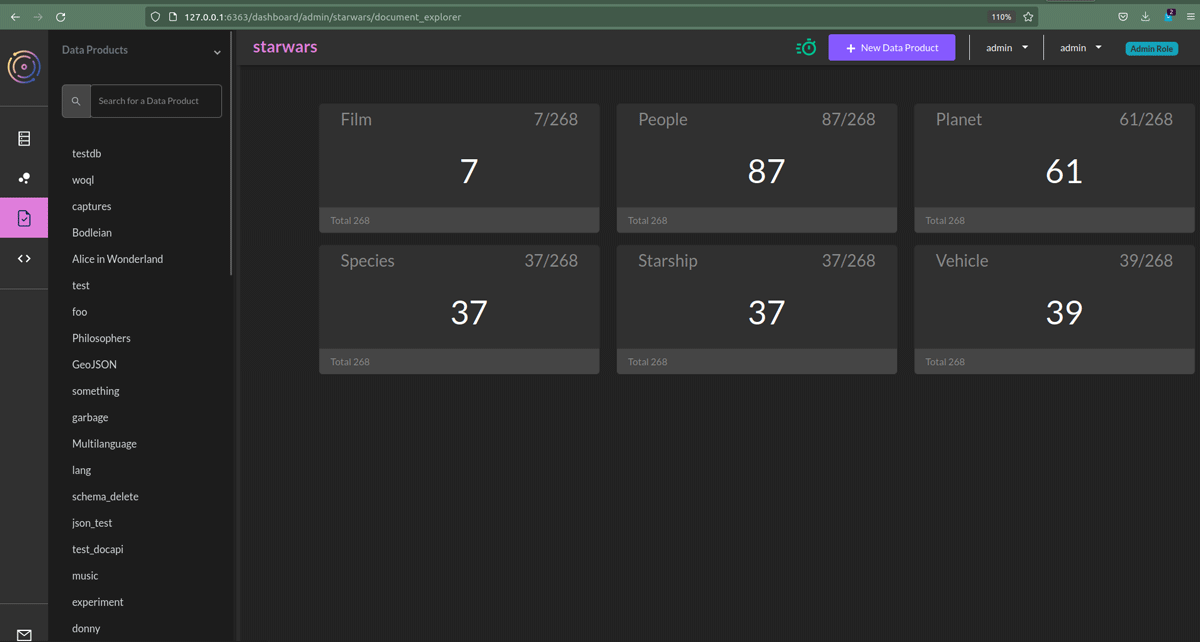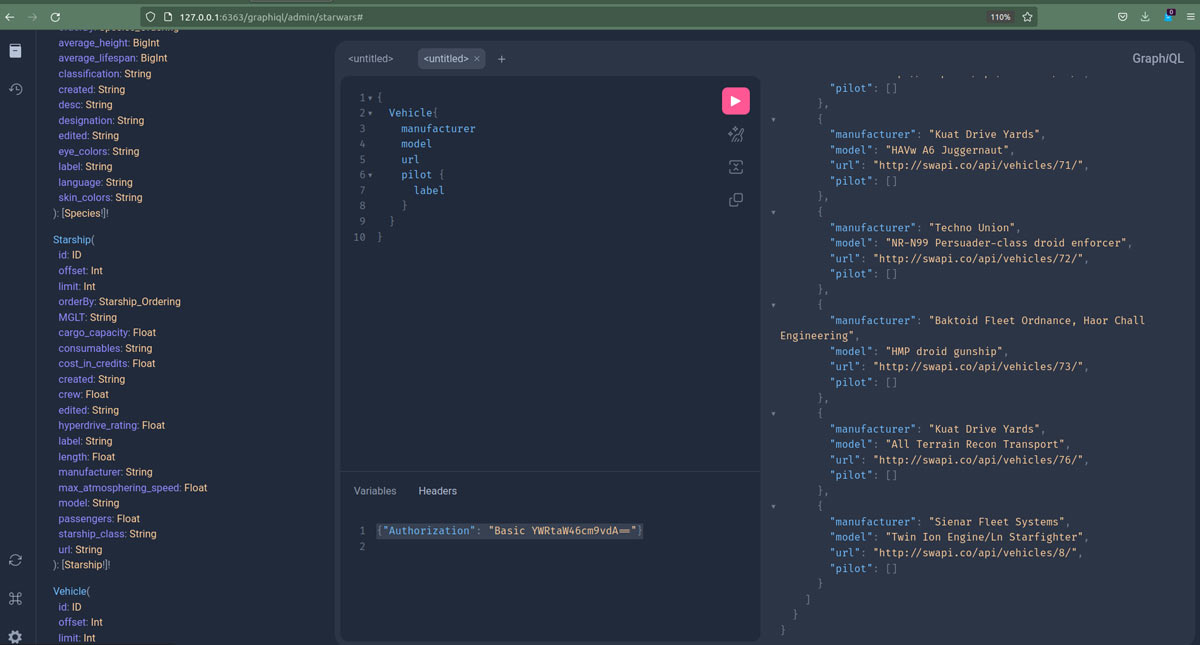GraphQL RDF Bridge Using Star Wars Dataset in TerminusDB
- Gavin
Since TerminusDB recently got GraphQL, I thought I’d do the done thing and load in the Star Wars Dataset and look at bridging GraphQL & RDF.

First, I looked around to find some JSON files that I could marshall into TerminusDB without too much trouble, but as I was looking I came across this DataSet: Star Wars Dataset. This not only has JSON files, but RDF!
I thought I’d take a crack at inserting RDF into TerminusDB and then querying it with GraphQL to see what was required.
RDF To TerminusDB
TerminusDB can read RDF files with little difficulty. However, to get the value of TerminusDB you really need a schema. So the first stop is to figure out how we massage the RDF to get it into an easily ‘schemable’ form.
The original star wars ttl is actually directly useable, but I don’t particularly like when the schema, and the data share the same namespace. For instance, here we have sw used for both people, and the type of people.
@prefix rdfs: <http://www.w3.org/2000/01/rdf-schema#> .
@prefix sw: <http://h2o.consulting/ns/star-wars#> .
@prefix xs: <http://www.w3.org/2001/XMLSchema#> .
sw:people-1 a sw:People .
sw:people-1 rdfs:label "Luke Skywalker" .
sw:people-1 sw:height "172" .
sw:people-1 sw:mass "77" .
...
To get rid of this, I decided to do a bit of sed scripting:
$ sed -ie 's/sw:\([A-Z]\)/schema:\1/' star-wars-dataset.ttl
$ sed -ie 's/ sw:\([^ ]*\) / schema:\1 /' star-wars-dataset.ttl
$ sed -ie 's/rdfs:label/schema:label'
This replaces all properties and types using sw: with schema:, and replaces all the rdfs:label with a local name – this look far less ugly when we use GraphQL (perhaps later we will allow local renaming of classes and properties for use in GraphQL).
Then we just swap out the prefixes in the header to yield this file:
@prefix rdfs: <terminusdb:///schema/star-wars#> .
@prefix sw: <terminusdb:///star-wars/> .
@prefix schema: <terminusdb:///schema/star-wars#> .
@prefix xs: <http://www.w3.org/2001/XMLSchema#> .
sw:people-1 a schema:People .
sw:people-1 rdfs:label "Luke Skywalker" .
sw:people-1 schema:height "172" .
sw:people-1 schema:mass "77" .
...
That’s all there is to it!
Now we can load it into TerminusDB from the command line. First we create the database, with schema checking turned off.
$ terminusdb db create admin/starwars --schema=false
Now we can load the turtle:
$ terminusdb triples load admin/starwars/local/branch/main/instance star-wars-terminusdb.ttl
Presto! We’ve got a Star Wars Database!
Making the Schema
Now it is possible to query the database with TerminusDB using WOQL. You can do this in the dashboard query panel, perhaps by using the query:
let [a, b, c] = vars("a", "b", "c")
limit(10,triple(a,b,c))
However, TerminusDB is much more useable when you give it a bit of a schema first.
We can use the Turtle file again to guide us in creating a schema.
We’ll open a file called star-wars.json and start typing:
[
{ "@type" : "@context",
"@base" : "terminusdb:///star-wars/",
"@schema" : "terminusdb:///schema/star-wars#"
}
]
This first bit is the context. It will tell us what instance and schema namespaces we have.
Now we’ll look at our ttl and see what kinds of things are defined:
sw:people-1 a schema:People .
sw:people-1 rdfs:label "Luke Skywalker" .
sw:people-1 schema:height "172" .
sw:people-1 schema:mass "77" .
sw:people-1 schema:hair_color "blond" .
sw:people-1 schema:skin_color "fair" .
sw:people-1 schema:eye_color "blue" .
sw:people-1 schema:birth_year "19BBY" .
sw:people-1 schema:gender "male" .
sw:people-1 schema:homeworld sw:planet-1 .
sw:people-1 schema:film sw:film-6 .
sw:people-1 schema:film sw:film-3 .
...
This has a bunch of properties that we should add to our star-wars.json schema.
Just below the context, we’ll define schema:People. Since we have stated in our context that the base for @schema matches the schema: prefix, we don’t need to specify it anymore in our objects.
This will look as follows:
...
{ "@type" : "Class",
"@id" : "People",
"name" : "xsd:string",
"height" : "xsd:decimal",
"mass" : "xsd:decimal",
"hair_color" : "xsd:string",
"skin_color" : "xsd:string",
"eye_color" : "xsd:string",
"birth_year" : "xsd:string",
"gender" : "xsd:string",
"homeworld" : "Planet",
"film" : { "@type" : "Set", "@class" : "Film" },
"species" : {"@type" : "Optional", "@class" : "Species"},
"starship" : {"@type" : "Set", "@class" : "Starship"},
"vehicle" : {"@type" : "Set", "@class" : "Vehicle"},
"url" : {"@type" : "Optional", "@class" : "xsd:anyURI"},
"label" : { "@type" : "Optional", "@class" : "xsd:string"}
},
...
Here we have a number of required properties, together with a number of Set properties. Sets can have any number of elements in the range. In addition we have a couple of Optional properties. These can be anything. The datatypes we use are from xsd, which lines up perfectly with the RDF we have imported.
I repeated this process for Film, Planet, etc. until I got what I felt was a complete TerminusDB Star Wars schema..
When I did the development, I added the classes, and properties I thought I needed, and then I loaded the schema and had a browse in the TerminusDB UI.
So:
$ terminusdb doc insert admin/starwars -g schema -f < star-wars.json
Documents inserted:
1: People
2: Film
3: Planet
4: Species
5: Starship
6: Vehicle
We should see something like:
terminusdb db update admin/starwars --schema=true
If there are any problems with the schema, this results in an error which will look something like:
{
"@type":"api:TriplesErrorResponse",
"api:error": {
"@type":"api:SchemaValidationError",
"api:witness": {
"@type":"unknown_property_for_type",
"property":"terminusdb:///schema/star-wars#pilot",
"type":"terminusdb:///schema/star-wars#Vehicle"
}
},
"api:message":"Schema did not validate after this update",
"api:status":"api:failure"
}
This is telling us that we are still missing a pilot property for Vehicle. I missed about 10 or 15 properties in total and then I was done!
I had to modify some brokenness in the ttl file too, since some properties were misspelled, and some had ranges which were inconvenient, mixing strings and integers for instance. But after reloading the triples I was able to do:
terminusdb db update admin/starwars --schema=true
Database updated: admin/star-wars
Now you can fully utilize the document interface in TerminusDB. You can browse through the People, Planets, Vehicles etc from the UI.
Search using GraphQL
But we also now get the GraphQL interface. In the graphql_endpoint experimental branch in TerminusDB (you can get this using the bootstrap by specifying graphql in your config) you can navigate to the following address:
http://127.0.0.1/graphiql/admin/starwars
You will then have to set the headers for your authorization. I use the default locally:
{"Authorization": "Basic YWRtaW46cm9vdA=="}
You will get a GraphQL user interface for the Star Wars data set! This is fully introspective and explorable, with a schema that is autogenerated. You can browse through the classes on the left, and use C-c C-c to get auto-completion.
It should look something like this:
Here you can enter in a query, such as:
{
Vehicle{
manufacturer
model
url
pilot {
label
}
}
}
This will get you all of the Vehicles, together with some associated specs, and all of the pilots who drove them in the Star Wars films.
We can also get some rudimentary search. For instance, we can ask for the vehicles in order, limiting the results to 3 and sorting by manufacturer.
{
Vehicle(limit:3, orderBy: { manufacturer : ASC }){
manufacturer
model
url
pilot {
label
}
}
}
This results with:
{
"data": {
"Vehicle": [
{
"manufacturer": null,
"model": "Fire suppression speeder",
"url": "http://swapi.co/api/vehicles/62/",
"pilot": []
},
{
"manufacturer": "Appazanna Engineering Works",
"model": "Oevvaor jet catamaran",
"url": "http://swapi.co/api/vehicles/69/",
"pilot": []
},
{
"manufacturer": "Appazanna Engineering Works",
"model": "Raddaugh Gnasp fluttercraft",
"url": "http://swapi.co/api/vehicles/70/",
"pilot": []
}
]
}
}
Note: null is less than any value.
We can also page these results by setting an offset:
{
Vehicle(limit:3, offset: 3, orderBy: { manufacturer : ASC }){
manufacturer
model
url
pilot {
label
}
}
}
And we get the next three…
{
"data": {
"Vehicle": [
{
"manufacturer": "Aratech Repulsor Company",
"model": "74-Z speeder bike",
"url": "http://swapi.co/api/vehicles/30/",
"pilot": [
{
"label": "Luke Skywalker"
},
{
"label": "Leia Organa"
}
]
},
{
"manufacturer": "Baktoid Armor Workshop",
"model": "Multi-Troop Transport",
"url": "http://swapi.co/api/vehicles/34/",
"pilot": []
},
{
"manufacturer": "Baktoid Armor Workshop",
"model": "Armoured Assault Tank",
"url": "http://swapi.co/api/vehicles/35/",
"pilot": []
}
]
}
}
You can likewise filter on the individual data fields. For instance, we can write:
{
Vehicle(manufacturer: "Aratech Repulsor Company"){
manufacturer
model
url
pilot {
label
}
}
}
And we will just get the “74-Z speeder bike”
{
"data": {
"Vehicle": [
{
"manufacturer": "Aratech Repulsor Company",
"model": "74-Z speeder bike",
"url": "http://swapi.co/api/vehicles/30/",
"pilot": [
{
"label": "Luke Skywalker"
},
{
"label": "Leia Organa"
}
]
},
]
}
}
We’re not done with the GraphQL schema generation yet. We’re keen to get back-links, which make it easy to follow arrows in reverse, path queries, and then complex filtering and full text search. However it’s already possible to do quite a lot!
We’re keen to see other example RDF datasets loaded and queryable in GraphQL with TerminusDB, so if you’ve anything in mind, drop us a line at our Discord!

